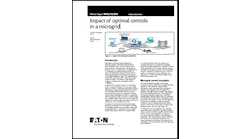Five Considerations for Designing DERs with Increased Energy Autonomy
Lauren Flanagan, executive chair and co-founder of Sesame Solar, discusses key considerations that simplify the process of designing distributed energy resources (DERs) that create energy autonomy.
Distributed energy resources (DERs) are significantly changing the way energy is produced, stored and distributed. Ideally, they are mobile and rapidly deployable to deliver power and essential resources when and where needed, especially after extreme weather events or emergencies. These DERs create energy autonomy by providing energy independence and self-sufficiency.
DERs can have a profound impact by providing extended periods of energy autonomy when the grid is down or unavailable. Combining renewable energy sources such as solar and battery storage with backup power from hydrogen fuel cells and wind turbines to achieve days, weeks or months of uninterrupted power can be complex and challenging, especially if the DERs need to be rapidly deployable. Here are five considerations to simplify the process.
1. Define the use case
The first consideration is to determine how the DER will be used. By determining how the DER unit will be used, you can then specify the type, size and additional energy sources that will need to be integrated to accommodate its energy and distribution requirements.
Sesame Solar DER designed for Cox Communications. Photo by Namit Jhanwar
Questions to ask:
- Primarily, will it be used to export power from renewable energy sources or will additional resources such as clean water, telecommunications, medical assistance, office space, EV charging, refrigeration or personal care such as toilets, showers, laundry or cooking facilities be needed?
- When and where will the DER be deployed?
- Will it be used only for grid outages and emergencies or in an ongoing manner?
- Will there be a need to cluster the DERs, for example, in a first responder base camp or to support evacuees after extreme weather events?
- What is the DER’s required life cycle?
- Who will transport and operate the DERs?
- What skills are required of the operators and how will they be trained?
2. Define mobility and footprint
Typically, a DER is used intermittently during grid outages or for emergencies. DERs used primarily for export power are constructed from smaller, 10 to 14 foot, dual-axle trailers and towed by a three-quarter-ton truck. DERs that incorporate other resources, such as an emergency office or telecommunications hub, generally are constructed from a larger, 16 to 20 foot, dual-axle trailer and towed by a one-ton truck.
Mobile DERs require the incorporation of lightweight materials and components such as flexible panel solar arrays, lithium-ion battery storage, proton exchange membrane hydrogen fuel cells (PEMs) and/or small, vertical wind turbines. Extra design attention needs to be given to the gross combined weight rating (GCWR) of the available transport equipment.
DERs used continuously in a semipermanent location must be moveable for emergencies or changes in location requirements. They are constructed from ISO shipping containers (10, 20 or 40 feet) and are towed on a flatbed trailer, which must meet CDL requirements.
Larger, containerized DERs are less weight-sensitive, allow for a larger solar array and battery storage to provide export power. They can incorporate more functionality, such as EV charging, a full medical clinic, toilets, showers and cooking facilities. Heavier and more energy-efficient alkaline hydrogen fuel cells can be used for backup power, and larger wind turbines can be integrated to provide export power from 100% renewable sources.
Sesame Solar DER with communications and Wi-Fi services. Photo by Namit Jhanwar
3. System sizing
Once the use case, location, mobility and footprint are defined, the energy requirements can be sized. The footprint of the DER generally determines the size of the solar array. Sesame Solar’s patent-pending, nanogrid DERs employ a retractable solar array to expand the energy generation into a smaller footprint.
The battery storage system must match the solar generation with additional storage capacity to accommodate inclement weather or wildfire smoke. However, it can’t be too much larger than can be recharged by the solar and backup power systems — hydrogen fuel cells and wind turbines, whose energy generation also must be matched to the capacity of the battery storage system. Clustered DERs share energy, potentially reducing individual DER energy generation and storage requirements. The component life cycles must match the longevity objectives for the DER.
Questions to ask:
- What is the expected peak energy use?
- What is the average energy use?
- How many days or weeks of uninterrupted power is needed?
- How many hours of sunlight are available in the needed location?
4. Designing for energy autonomy
Extended energy autonomy DERs generally require multiple energy inputs and an energy management system to seamlessly toggle among them. Sesame Solar nanogrid DERs include a variety of essential services in addition to exporting power from multiple renewable energy inputs. AC export power and the essential services are provided by lithium ferro phosphate (LFP) batteries, which contain no cobalt and have a lower thermal runaway. Solar power is the primary energy source for the LFP storage in Sesame Solar nanogrids and hydrogen fuel cells provide backup power.
Sesame Solar mobile, turnkey nanogrid DER. Photo by Namit Jhanwar
These nanogrids make green hydrogen from electrolysis and it’s stored in low compression, non-pyrophoric, solid-state tanks providing hydrogen to the fuel cell. When the LFP batteries are depleted to approximately 35%, the necessary days of energy autonomy are created by matching the hours of hydrogen storage to the hydrogen fuel cell intake rate, and the rate of production of hydrogen from electrolysis, while the solar array replenishes the battery pack.
The use case, energy management system and battery storage capacity determine the optimal settings for switching from solar to hydrogen power and back. Small wind turbines can provide gap-filling renewable power in areas where there is sufficient wind.
5. Designing for rapid deployment
DERs that are shipped ready-to-use with a completely integrated renewable energy system are rapidly deployable and set up quickly to meet sudden grid outages or emergencies. Ease of use comes from the DERs’ comprehensive system design, process automation, hazmat and safety integration, management of consumables (water and electrolytes), remote software guidance, system health-monitoring applications, augmented reality for field training and support, and regular maintenance to keep the DER performing well throughout its life expectancy.
A careful review of these considerations produces a DER with power from multiple renewable energy sources, essential services when and where they are needed and for as long as they are needed.
Lauren Flanagan is the executive chair and co-founder of Sesame Solar where she leads strategic initiatives.







